Finding out you’re expecting is a whirlwind of emotions and changes, and one common question that pops up is about exercise. Can you stay active? Should you? For most healthy pregnancies, the answer is a resounding yes! Staying active offers a host of benefits for both you and your growing baby. It’s not about training for a marathon (unless you already were!), but about incorporating gentle, consistent movement into your routine.
Think of it as preparing your body for the incredible journey ahead. Regular, moderate activity can help ease some common pregnancy discomforts like backaches, constipation, and bloating. It can boost your mood and energy levels, which can sometimes take a dip during pregnancy. Plus, staying active might help you sleep better and manage stress more effectively. There’s even evidence suggesting it can help prepare your body for labor and delivery and potentially make postpartum recovery a bit smoother.
Getting Started: The Golden Rules
Before you lace up your sneakers or roll out your yoga mat, the absolute first step is crucial: talk to your doctor or midwife. Every pregnancy is unique, and your healthcare provider knows your specific situation. They can give you the green light to exercise and offer personalized guidance based on your health history and the progress of your pregnancy. They’ll let you know if there are any reasons why exercise might not be recommended for you, or if certain activities should be avoided.
Once you have clearance, the key is moderation and listening intently to your body. Pregnancy isn’t the time to push yourself to new fitness extremes. If you were active before pregnancy, you can likely continue with some modifications. If you weren’t very active before, start slowly. Even 15-20 minutes of gentle activity most days of the week can make a difference. Gradually increase the duration as you feel comfortable, aiming for around 30 minutes of moderate-intensity activity on most, if not all, days, as generally recommended for healthy adults and pregnant women.
Important Safety Note: Always consult your healthcare provider before starting or continuing any exercise program during pregnancy. They can assess your individual health status and provide tailored advice. Never exercise to the point of exhaustion, and stop immediately if you feel pain, dizziness, shortness of breath, or any other concerning symptoms.
What Does “Moderate Intensity” Mean During Pregnancy?
This is where the “talk test” comes in handy. During moderate-intensity exercise, you should be able to hold a conversation without gasping for breath. You’ll notice your heart rate is elevated and you’re breathing a bit heavier, but you shouldn’t be completely out of breath. If you can sing, you might need to pick up the pace slightly. If you can’t speak comfortably, you’re likely pushing too hard.
Remember, your body is already working hard growing a baby! Your heart rate is naturally a bit higher during pregnancy, and your oxygen needs increase. So, the intensity that felt moderate pre-pregnancy might feel more strenuous now. Pay attention to these changes and adjust accordingly.
Great Activities to Consider (With Doctor’s Okay!)
Many activities are generally considered safe and beneficial during pregnancy, provided you have your doctor’s approval and make necessary adjustments:
- Walking: Simple, accessible, and effective. It’s easy on the joints and a great way to get started or maintain fitness.
- Swimming and Water Aerobics: Often called the ideal pregnancy workout! The water supports your weight, reducing impact on joints and easing swelling. It provides resistance for a good workout while keeping you cool.
- Stationary Cycling: A good cardiovascular workout without the risk of falls associated with outdoor cycling. Ensure the handlebars are adjusted for comfort as your belly grows.
- Prenatal Yoga: Specifically designed for expectant mothers, it focuses on stretching, mental centering, and breathing techniques. It can improve flexibility and reduce stress but be sure to choose a certified prenatal instructor and avoid certain poses (like deep twists or lying flat on your back for extended periods later in pregnancy).
- Low-Impact Aerobics: Look for classes designed for pregnant women or modify regular low-impact routines by avoiding jumps, jarring movements, and quick changes in direction.
- Modified Strength Training: Using lighter weights or resistance bands can help maintain muscle tone. Focus on good form and avoid holding your breath (the Valsalva maneuver). Your doctor or a qualified trainer experienced with prenatal clients can guide you on safe exercises.
Activities to Approach with Caution or Avoid
As your body changes, your center of gravity shifts, your joints become looser (thanks to the hormone relaxin), and your balance might be affected. Therefore, some activities pose a higher risk:
- Contact Sports: Activities with a high risk of collision or abdominal trauma (like hockey, boxing, soccer, basketball) should generally be avoided.
- Activities with High Fall Risk: This includes things like downhill skiing, water skiing, surfing, outdoor cycling (especially later in pregnancy), gymnastics, and horseback riding.
- Scuba Diving: This is a definite no-go due to the risk of decompression sickness for the baby.
- Exercise in Hot, Humid Weather: Overheating can be dangerous during pregnancy. Exercise indoors in air conditioning or choose cooler times of the day, and drink plenty of water. Avoid hot yoga or saunas.
- Exercises Lying Flat on Your Back: After the first trimester, lying flat on your back can potentially compress a major vein (the vena cava), reducing blood flow to your heart and uterus. Modify exercises accordingly (e.g., prop yourself up with pillows).
- High Altitude Exercise: If you don’t normally live at high altitude, avoid exercising above 6,000 feet, as it can reduce oxygen supply to the baby.
- Activities Involving Bouncing or Jarring Movements: High-impact aerobics or running might become uncomfortable or risky as pregnancy progresses, especially if you weren’t a runner before. Listen to your body.
Listen to Your Body: Warning Signs to Stop Exercising
Your body gives you signals when something isn’t right. It’s crucial to stop exercising immediately and contact your doctor or midwife if you experience any of the following:
- Vaginal bleeding
- Dizziness or feeling faint
- Shortness of breath before starting exercise
- Chest pain
- Headache
- Muscle weakness affecting balance
- Calf pain or swelling (could indicate a blood clot)
- Regular, painful uterine contractions
- Fluid leaking from the vagina (amniotic fluid)
Staying Hydrated and Fueled
Drinking water is always important, but it’s especially critical during pregnancy and even more so when you’re exercising. Drink water before, during, and after your workout. Don’t wait until you feel thirsty. Keep a water bottle handy at all times.
Also, make sure you’re eating enough to fuel both your pregnancy and your activity levels. You might need a small, easily digestible snack about an hour before exercising if you haven’t eaten recently. Focus on balanced meals and snacks throughout the day.
Comfort is Key
Wear comfortable, loose-fitting clothing and supportive footwear. A good supportive bra, possibly a sports bra designed for pregnancy, is essential as your breasts change. As your belly grows, you might also find maternity support belts helpful during certain activities like walking.
Staying active during pregnancy is generally a fantastic way to support your well-being and prepare for the journey ahead. By prioritizing communication with your healthcare provider, choosing appropriate activities, listening closely to your body’s signals, and focusing on moderation and safety, you can enjoy the many benefits of movement throughout your pregnancy. Remember, it’s about finding enjoyable ways to move your body safely, not about pushing limits. Enjoy this special time and the connection you build with your body and baby through gentle activity.








